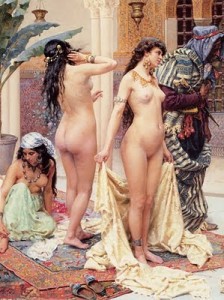The answer us that it sounds exactly like an Arabian Night.
But really it’s a Parisian night, from the early twentieth century, put into English a little later by a London-based Welshman, Edward Powys Mathers.
Mathers’s version is probably still the most popular English-language version of “The Thousand Nights and a Night”. But he didn’t know a word of Arabic. He translated the French version by Joseph Charles Mardrus.
Mardrus knew Arabic, but he also wrote his own mildly erotic Oriental fantasies, like his “The Queen of Sheba”, which is all gold costumes (underwear that goes “clank” when you drop it), yearning glances and shuddering thighs. Then in the early 1920s, Mathers did an English version of Mardrus’s French. The original is two generations away from the English version.
I discovered all this when I went searching for other translations of the Princess Abrixa scene when I was researching my “Between the Lines”. “Between the Lines” among other things tries to sketch in a cultural history of bdsm. I wanted to show that there’s awareness of bdsm pleasures in pretty much all world literatures, not just the European ones. But when I checked the Burton translation, the bound and spanked girls weren’t there. There were only some chaste athletic competitions.
So I checked other translations, and discovered that the bondage and spanking doesn’t appear in any other translation. Mardrus and Mathers had made it up. Well, the athletics was probably enough to keep Sharkhan happily watching, hiding in his tree, but it isn’t quite so saucy for the reader. Mardrus and Mathers knew what an Arabian night ought to be like, even if the original Arabic writer didn’t.
I fixed the immediate problem for my book by dropping the “Arabian Nights” reference, and substituting some early medieval Arabic medical texts that showed some awareness of bdsm, or at least of sexual responses to whipping. But it was a pity to have to lose that warm, all-girl spanking night by the pool.


